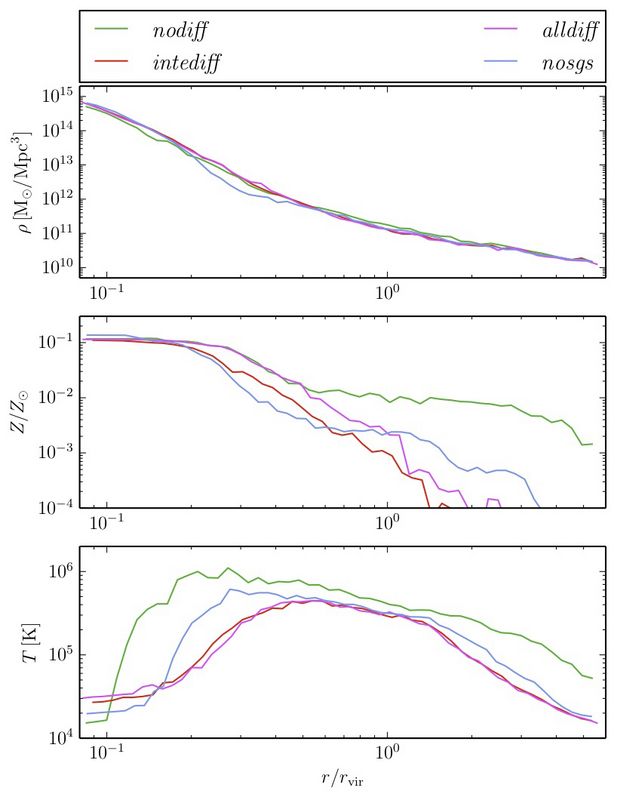ASTROPHYSICS
Metal Enrichment by Turbulent Mixing in Cosmological Simulations
Principal Investigator:
Wolfram Schmidt
Affiliation:
Institut für Astrophysik, Universität Göttingen, and Hamburger Sternwarte, Universität Hamburg (Germany)
Local Project ID:
pr84vo
HPC Platform used:
SuperMUC of LRZ
Date published:
The modelling of star formation and feedback processes such as supernova explosions is a longstanding problem in numerical simulations of cosmological structure formation because the internal structure of galaxies cannot be resolved in sufficient detail even on very powerful supercomputers. For this reason, star formation and stellar feedback are treated as so-called subgrid physics. The aim of our project is to combine standard recipes for star formation in simulations on cosmological scales with a subgrid-scale model for numerically unresolved turbulence, which allows us to study the influence of turbulence on star formation and the mixing of metals expelled by supernova explosions in galaxies. It is believed that, in addition to supernovae-driven galactic outflows, turbulent mixing plays a significant role for the enrichment of metals in the intergalactic medium. However, the results of our project reveal a complex interplay of all processes which leads to surprising conclusions. While the additional non-thermal energy reservoir introduced by our subgrid-scale model allows for a higher feedback efficiency, which in turn produces stronger outflows of metal-enriched gas from galaxies, incorporating turbulent mixing of heat and metals into the model does not necessarily result in enhanced metal enrichment because mixing competes with feedback.
Introduction
Despite the overall success of the standard model of cosmology in explaining the large-scale structure of the universe, the physics of the gravitationally bound gas in galaxies is far from being fully understood. Generally speaking, observations are consistent with the fact that the gas in star forming regions is strongly driven, far from equilibrium, and coupled to external flows with varying degrees of strength. Hydrodynamic simulations of galaxy formation are in agreement with this general statement. Simulations of isolated galaxies, as well as those with a dynamical cosmological background, show highly intermittent star formation rates causing strongly fluctuating density and velocity fields. The dynamics of the interstellar material (ISM) within galaxies is equally affected by the nonlinearity of the Euler equations of gas dynamics, resulting in turbulence, and the complex interplay of heating and cooling mechanisms that are employed to model the unresolved effects of stars and supernovae, all of which is coupled to in- and outflows in a time dependent gravitational potential.
In a preceding HPC project (Star Formation in the Turbulent Interstellar Medium) simulations of isolated disk galaxies on scales resolving the clumpy multi-phase ISM were performed [1, 2]. It was based on a subgrid-scale (SGS) model for compressible turbulence coupled to the different thermal states of the ISM by production of unresolved turbulence, thermal dissipation, and mixing through turbulent diffusion and showed a surprisingly multifaceted interplay of effects on the physics of star formation. In combination, these effects lead to reduced cooling and increased thermal feedback, both of which suppress the star formation efficiency. On the other hand, turbulent mixing of energy and metals enhances the cooling efficiency of gas with high temperatures and low metallicities (i.e. the fraction of elements heavier than hydrogen and helium), counteracting the former effects.
In this project, a modified version of the multi-phase SGS turbulence model [2] is applied in simulations of multiple galaxies in their environment (the so-called intergalactic medium, IGM) on cosmological scales [3]. This encompasses the dynamical treatment of dark matter by N-body solvers and cosmological expansion of the Universe. In contrast to the model employed in isolated disk galaxies, the modified SGS model does not explicitly keep account of the separate gas phases and therefore does not require parsec-scale numerical resolution of the ISM. It does, however, retain the full dynamics of the unresolved turbulence (i.e. turbulent eddies on scales smaller than the grid resolution scale of the simulation) and turbulent diffusion of thermal energy [4]. In addition, the impact of turbulent mixing on the chemical composition and energetic coupling to stellar feedback is included. It is thus the most comprehensive model for the dynamics of hydrodynamic turbulence on unresolved scales employed in cosmological simulations to date.
Results
The SGS model was implemented into the cosmological adaptive-mesh-refinement code Nyx [5], which is publicly available from github.com/AMReX-Astro/Nyx. In a suite of simulations, we successively switched on different components of the model to investigate the impact on star formation and metal enrichment of the gas through turbulent mixing.
To analyse the simulation data, a variety of statistics were computed. For example, the mean star formation rate is expected to reach roughly 0.1 solar masses per year in a volume of one cubic megaparsec around a redshift of two (redshift is used as a measure of cosmological time). This follows both from observations and simulations (see Fig. 1). Although the differences between the different models are generally small, we find that the main effect of the SGS model for numerically unresolved turbulence is an enhancement of stellar feedback. This in turn decreases of the star formation rate (nodiff vs nosgs in Fig. 1). However, switching on turbulent diffusion partially compensates this effect (alldiff vs nodiff).

Figure 1: Average star formation rate as function of redshift in different simulations (lines) and from observations (vertical bars).
Copyright: Institut für Astrophysik, Universität Göttingen (Germany)Gas properties and the distribution of metals are compared in radial profiles averaged over many galactic halos (see Fig. 2). Contrary to expectations that the enhancement of mixing by turbulent diffusion should help to enrich the CGM with metals, we find only a small effect on the distribution of metals. It appears that diffusion is insufficient to overcome the inward motion of accretion flows (the gas being pulled from the IGM into galaxies by gravity), while outflows driven by supernova feedback are much more efficient in expelling metals. Since these outflows happen to be stronger in the simulation without turbulent diffusion (nodiff), metals are also spread out to larger radii in that case (middle panel in Fig. 2). This is also reflected in a broader temperature profile (bottom panel).

Figure 2: Averaged radial profiles of the gas density (top), metallicity (middle), and temperature (bottom) for galactic halos.
Copyright: Institut für Astrophysik, Universität Göttingen (Germany)Our project results indicate that a SGS model may help to decrease the numerical overcooling and to increase the efficiency of feedback in star-forming regions in galaxy simulations. However, we still lack a fully consistent treatment of all subgrid processes. Particularly the role of turbulent diffusion remains unclear. To solve this problem, it is crucial to gain a better understanding of both turbulent transport and microphysical processes, including magnetic fields and the multiphase structure of the gas.
Publications:
1. Braun, H. and W. Schmidt, A semi-analytic model of the turbulent multi-phase interstellar medium. Monthly Notices of the Royal Astronomical Society, 2012. 421(3): p. 1838-1860.
2. Braun, H., et al., Large-eddy simulations of isolated disc galaxies with thermal and turbulent feedback. Monthly Notices of the Royal Astronomical Society, 2014. 442(4): p. 3407-3426.
3. Engels, J.F., W. Schmidt, and J.C. Niemeyer, Modelling turbulent effects of stellar feedback in cosmological simulations. Monthly Notices of the Royal Astronomical Society, submitted.
4. Schmidt, W., et al., Cosmological fluid mechanics with adaptively refined large eddy simulations. Monthly Notices of the Royal Astronomical Society, 2014. 440(4): p. 3051-3077.
5. Almgren, A.S., et al., Nyx: A massively parallel AMR code for comutational cosmology. The Astrophysical Journal, 2013. 765(1): p. 39-39.
Scientific Contact:
Dr. Wolfram Schmidt
Institut für Astrophysik, Universität Göttingen, and Hamburger Sternwarte, Universität Hamburg (Germany)
e-mail: wolfram.schmidt[at]uni-hamburg.de